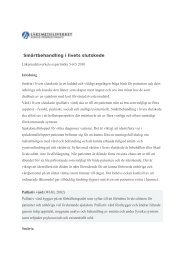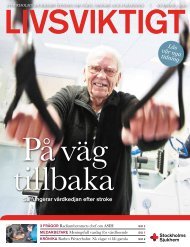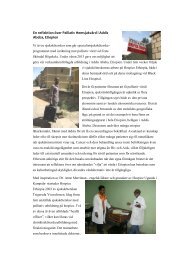Physiotherapy in palliative careâ - Stockholms sjukhem
Physiotherapy in palliative careâ - Stockholms sjukhem
Physiotherapy in palliative careâ - Stockholms sjukhem
You also want an ePaper? Increase the reach of your titles
YUMPU automatically turns print PDFs into web optimized ePapers that Google loves.
Common problems for patients who have cancer <strong>in</strong> a <strong>palliative</strong> phaseMetastasis of the skeletonMetastasis of the skeleton is the most common cause of pa<strong>in</strong> for patients with cancer.Metastases of the skeleton can be seen with all k<strong>in</strong>ds of cancer but most common with breastandprostate cancer. It is also common with metastasis of the skeleton with lung- kidney andthyroid gland cancer.The most common localization for metastases is the sp<strong>in</strong>e, skull bone, pelvis upper part thehumerus and upper part of the femur.Metastases of the skeleton often result <strong>in</strong> destruction of bone tissue – osteolysis – rather than thebone tissue becom<strong>in</strong>g osteosclerotic and the skeleton will gradually deteriorate and becomedecalcified. The skeleton around the metastasis becomes very fragile and the risk for fractures<strong>in</strong>creases. Radiation therapy is often used for pa<strong>in</strong> and also to prevent pathological fractures andcompression of the vertebrae or to lessen the compression of the sp<strong>in</strong>e. (13, 14)Pathological fracturesA pathological fracture is a fracture that can occur without prior trauma to the skeleton which isfragile for example because of metastasis. In the extremities it is mostly femur and humerus thatare affected. With a pathological fracture there is no normal fracture heal<strong>in</strong>g process. Surgicaltreatment can be needed to make the jo<strong>in</strong>t stable, pa<strong>in</strong> free and function<strong>in</strong>g. Radiation treatmentcan be used to reduce the pa<strong>in</strong> and <strong>in</strong>crease stability.The post operative mobiliz<strong>in</strong>g of the patient does not differ from mobiliz<strong>in</strong>g patients with otherfractures, but there might be a different pattern of pa<strong>in</strong> and the illness itself or the treatment canaffect the patient’s general condition and be a h<strong>in</strong>drance to mobilization. (14)It is common that patients who have had a pathological fracture <strong>in</strong> spite of the fact that theyhave received surgical treatment and can be mobilized, are very afraid of gett<strong>in</strong>g out of bed andstand<strong>in</strong>g on the leg. With <strong>in</strong>formation about the stability of the fracture, support andencouragement the patient can feel safe and dare to use the leg aga<strong>in</strong>, this way function can berega<strong>in</strong>ed and complications from ly<strong>in</strong>g <strong>in</strong> bed can be h<strong>in</strong>dered.<strong>Physiotherapy</strong> <strong>in</strong> <strong>palliative</strong> care – a cl<strong>in</strong>ical handbook Ulla Frymark, Lilian Hallgren, Ann‐Charlotte Reisberg 15

















